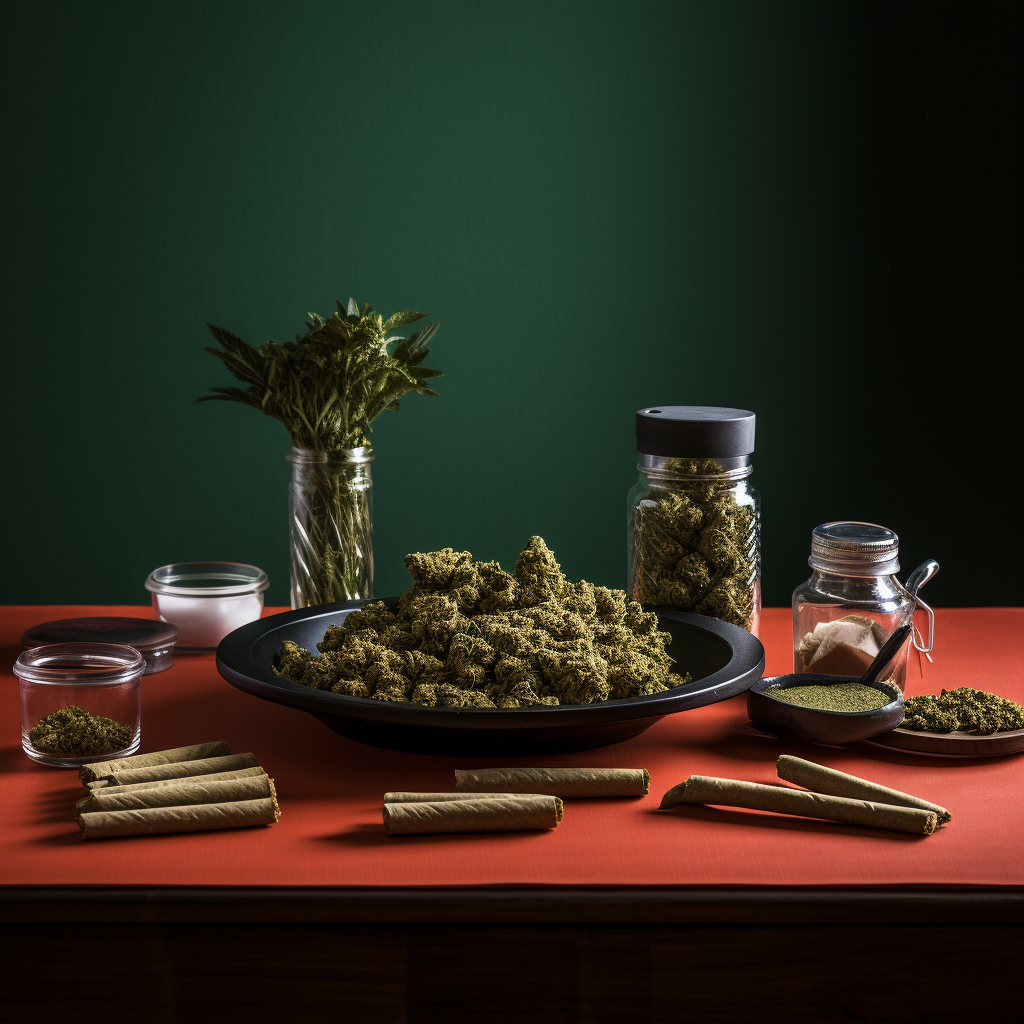Joint vs Blunt

What Is the Difference Between a Joint and a Blunt?
If you've ever found yourself in a smoke circle or browsing through a dispensary, you've probably come across two popular cannabis consumption methods: joints and blunts. While they may seem similar at first glance, there are actually some key differences between the two. In this article, we'll delve into the world of joints and blunts to help you understand what sets them apart.
Understanding the Basics: Joints and Blunts
Before we get into the nitty-gritty details, let's start with the basics. Both joints and blunts are methods of smoking cannabis, but there are some fundamental distinctions to consider.
When it comes to the world of cannabis consumption, joints and blunts are two popular choices that have stood the test of time. Each has its own unique characteristics and appeal, making them favorites among cannabis enthusiasts.
Definition of a Joint
Generally speaking, a joint is a cannabis cigarette rolled using rolling papers. These papers are specially designed to burn smoothly, allowing you to enjoy the flavor and effects of the herb. Joints have been around for decades and are a classic choice for cannabis enthusiasts.
Rolling a joint is considered an art form by many cannabis connoisseurs. It requires skill and finesse to create a perfectly rolled joint that burns evenly and provides a satisfying smoking experience. The process involves carefully selecting the right strain of cannabis, grinding it to the perfect consistency, and evenly distributing it within the rolling paper.
One of the advantages of smoking a joint is the ability to fully appreciate the flavors and nuances of the cannabis strain. The rolling papers used for joints are typically thin and flavorless, allowing the natural terpenes and cannabinoids of the herb to shine through. This makes joints a popular choice for those who want to experience the full spectrum of a strain's effects.
Definition of a Blunt
In contrast, a blunt is a cannabis cigar rolled using tobacco paper, which is commonly known as a "blunt wrap." Unlike joints, blunts typically incorporate some tobacco, lending a unique flavor and potentially altering the overall smoking experience.
Blunts have a rich history that dates back to the early days of cannabis consumption. They originated in the hip-hop culture of the 1970s and quickly gained popularity among music artists and enthusiasts alike. Rolling a blunt requires a different set of skills compared to rolling a joint, as the tobacco paper used is thicker and requires a different technique.
The addition of tobacco in a blunt wrap adds a distinct flavor profile to the smoking experience. The combination of cannabis and tobacco creates a unique taste that some find enjoyable and others find overwhelming. Blunts are often associated with a more intense and robust smoking experience, making them a preferred choice for those seeking a stronger high.
It's worth noting that blunts are generally larger than joints, allowing for a greater amount of cannabis to be consumed in a single session. This makes them a popular choice for group smoking sessions or for those who prefer a longer-lasting experience.
Whether you prefer the simplicity and purity of a joint or the boldness and complexity of a blunt, both methods offer a unique way to enjoy the benefits of cannabis. The choice between the two ultimately comes down to personal preference, as each has its own distinct qualities that cater to different tastes and desires.
The Anatomy of a Joint and a Blunt
Now that we've covered the definitions, let's take a closer look at the components that make up joints and blunts.
Rolling a joint or a blunt is an art form in itself. It requires precision, skill, and an understanding of the materials used. Both joints and blunts have their unique characteristics, offering different smoking experiences to enthusiasts.
Materials Used in Joints
Joints are typically rolled using rolling papers made from various materials, such as rice, hemp, or even cellulose. These papers are thin, lightweight, and burn evenly, allowing for a smooth smoking experience. The choice of rolling paper material can affect the flavor and burn rate of the joint.
Rice rolling papers, for example, are known for their slow burn and minimal interference with the taste of the cannabis. They are often favored by purists who want to fully experience the natural flavors and aromas of the strain.
Hemp rolling papers, on the other hand, are popular among environmentally conscious smokers. These papers are made from the fibers of the hemp plant, a sustainable and renewable resource. Hemp rolling papers are known for their durability and ability to enhance the overall smoking experience.
For those looking to add an extra layer of flavor, flavored rolling papers are a popular choice. These papers are infused with various flavors like strawberry, mango, or even chocolate. They can complement the taste of the cannabis, creating a unique and enjoyable smoking experience.
Materials Used in Blunts
On the other hand, blunts are rolled using tobacco paper, which is thicker and more robust than rolling papers. This tobacco component can significantly impact the taste and aroma of the smoke, often infusing it with hints of tobacco flavor. The choice of tobacco paper can greatly influence the overall smoking experience.
Blunts are known for their bold and rich flavors, thanks to the tobacco wrap. The tobacco paper can add a slightly sweet and earthy taste to the cannabis, creating a unique blend of flavors. Some smokers appreciate the combination of cannabis and tobacco, while others prefer a milder taste.
It's worth noting that blunts can also be filled with all cannabis, called a "backwood." Backwoods are a popular choice among cannabis enthusiasts who enjoy the natural taste and aroma of the strain without any added tobacco flavor. Rolling a backwood requires carefully removing the tobacco from a cigar wrap and replacing it with ground cannabis.
Whether you prefer the clean and pure experience of a joint or the robust and flavorful nature of a blunt, the choice of materials plays a crucial role in shaping your smoking experience. Experimenting with different rolling papers or tobacco wraps can open up a world of flavors and sensations for cannabis enthusiasts.
The Smoking Experience: Joints vs Blunts
When it comes to the actual smoking experience, there are a few distinct factors that differentiate joints from blunts.
Flavor and Aroma Differences
The choice between a joint and a blunt can have a significant impact on the flavor and aroma of your smoking session. Joints, rolled with pure rolling papers, tend to deliver a more herbal taste that highlights the natural flavors and terpenes of the cannabis strain. Blunts, on the other hand, can introduce a hint of tobacco flavor, which may complement or overpower the cannabis notes.
Burn Rate and Duration
Another crucial aspect to consider is the burn rate and duration of joints versus blunts. Due to their thinner rolling papers, joints tend to burn at a faster rate. This can result in a quicker smoking session, which may be preferable for those seeking a more efficient experience. In contrast, blunts, with their thicker tobacco wraps, tend to burn slower, allowing for a more prolonged and leisurely smoke.
Health Implications of Joints and Blunts
While joints and blunts can offer enjoyable smoking experiences, it's essential to be aware of the potential health risks associated with each.
Health Risks Associated with Joints
Joints, being rolled with pure rolling papers, offer a relatively healthier option compared to blunts. However, it's worth noting that smoking any combustible substance, including cannabis, can still have adverse effects on the respiratory system. To minimize potential harm, some individuals opt for alternatives like vaporizers or edibles.
Health Risks Associated with Blunts
Blunts, due to their tobacco paper component, introduce additional risks associated with tobacco use. The combination of cannabis and tobacco can exacerbate respiratory issues and create a higher addiction potential. If smoking is your preferred consumption method, it may be beneficial to consider alternatives that minimize exposure to tobacco.
Cultural and Social Differences
Beyond the technical distinctions, joints and blunts also hold cultural significance and play distinct roles in popular culture.
The Role of Joints in Popular Culture
Joints have long been associated with counterculture movements, representing freedom of expression and a more laid-back approach to cannabis consumption. They have become iconic symbols, appearing in movies, music, and artwork, making them a staple in cannabis culture.
The Role of Blunts in Popular Culture
Blunts, on the other hand, have developed a unique identity within hip hop and urban communities. Historically, blunts were popularized as a way to stretch the value of cannabis by mixing it with tobacco. Today, they remain a go-to choice for many who enjoy the flavor combination and the ritualistic aspect of rolling a cigar-like cannabis creation.
In conclusion, while joints and blunts both provide ways to enjoy cannabis, understanding their differences can aid in finding the consumption method that best suits your preferences. Whether you prefer the simplicity and pure taste of a joint or the robust flavor and leisurely burn of a blunt, the choice ultimately comes down to personal preference and the experience you seek. So, light up, relax, and enjoy your herb in whichever way brings you the most satisfaction.



